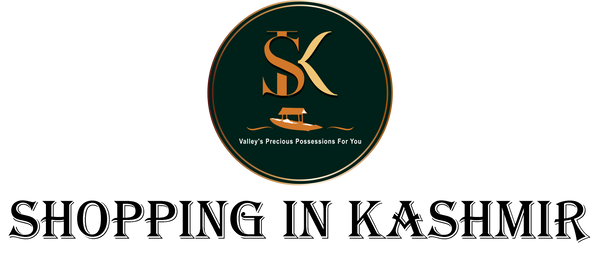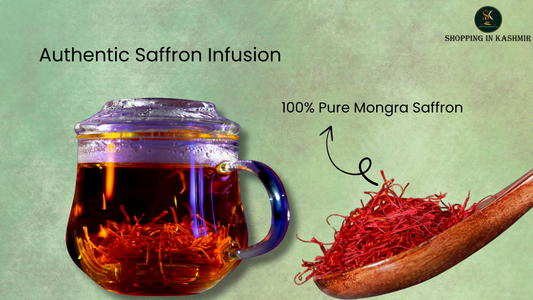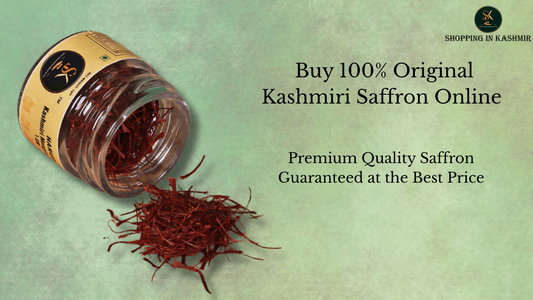How to Identify Original Kashmiri Mongra Saffron at Home
Share
Table of Contents
What is Kashmiri Mongra Saffron?
Which Kashmiri Saffron is Best?
Characteristics of Pure Kashmiri Saffron
1. What Colour Should Saffron Be?
2. Shape of 100% Pure Saffron Thread
3. Dryness and Texture of Pure Saffron
4. Length and Uniformity
5. Aroma of Original Saffron
6. Taste of Kashmiri Mongra Saffron
How to Test Original Kashmiri Mongra Saffron at Home
1. Cold Water Test
2. Diffusion Time Test
3. Hot Water Test
4. Taste Test
5. Smell Test
6. Rub Test
7. Paper Test
8. Baking Soda Test
9. Appearance Check
10. Petrol (Gasoline) Test
11. Solubility Test - Does Real Saffron Dissolve in Water?
Does Saffron Expire? How to Store It
The Shopping in Kashmir brand sells original saffron
Kashmiri Mongra saffron, often called “red gold,” is the world’s most prized saffron. It is hand-harvested in Pampore, famously known as the “saffron town” of India. This rare spice can cost up to ₹3,25,000 per kg because of its intense colour, aroma, and flavour.
Such high value and also its rarity makes it a common target for adulteration. That is why buyers must know how to spot authentic Kashmiri Mongra Saffron.
In this guide by Shopping in Kashmir, a brand that partners directly with Pampore farmers, we explain what Mongra saffron is, why Kashmiri saffron is famous, and how to test saffron’s purity at home. This way, you will always be sure you are getting genuine, Grade-1 Kashmiri saffron.
What is Kashmiri Mongra Saffron?
Kashmiri Mongra saffron (also called Mogra saffron) is the highest grade of saffron available. It is made only from the deep red stigmas of the saffron flower, with no yellow style attached. Each saffron flower in Kashmir has three delicate red threads, about 2–3 cm long. When farmers hand-pick and carefully separate these threads from the pale yellow style, the result is pure Mongra saffron.
Mongra saffron contains around 10% more crocin pigment than other grades, which makes it deeper in colour, more aromatic, and more flavourful. By comparison, Lacha saffron still has a bit of the yellow style attached, and Guchhi saffron keeps the entire filament. Both are considered lower in quality than Mongra saffron.
In Kashmir, Mongra saffron is known as Grade-1 saffron. It is prized worldwide for its silky texture, bright crimson red colour, and powerful aroma. These qualities are due to the region’s unique climate and high altitude, Pampore saffron is among the darkest and richest saffron in the world. It has an exceptional crocin content of 8.72%, which gives it its deep red appearance and the golden-yellow colour when soaked.
Importantly, Kashmiri saffron holds a Government GI (Geographical Indication) tag, a mark of authenticity that protects its unique identity and assures you are buying the original Kashmiri Saffron.
Which Kashmiri Saffron is Best?

The best Kashmiri saffron is Mongra (Mogra) Grade I, made only from the pure red stigmas of the saffron flower. Unlike other grades, Mongra contains no yellow styles, just the deep crimson threads that carry the highest concentration of crocin (colour strength) and safranal (aroma). This makes it more potent, more aromatic, and more valuable than lower-quality varieties. This justifies why Kashmiri Saffron is famous all around the world, despite the availability of many other varieties.
Authentic Kashmiri Mongra saffron is considered the most desirable form of saffron worldwide. For both cooking and medicinal purposes, Mongra is the preferred choice. In fact, in different regions it is also known as “Coupe” in Spain and “Zafran-e-sar-gol” in Iran.
Saffron strands with yellow parts, pale ends, or broken threads are not Grade-1 Mongra saffron from Pampore, Kashmir. Such products are either inferior or adulterated. Pure Kashmiri Mongra saffron should always be uniform, crimson-red, and clean.
Since we care for your safety and authenticity, we always recommend to buy Kashmiri saffron from trusted sources. At Shopping in Kashmir, we follow this principle by sourcing only Grade-1 Mongra saffron directly from Pampore farmers, guaranteeing you genuine, farm-to-home purity.
Characteristics of Pure Kashmiri Saffron
Authentic Kashmiri saffron has unique qualities that make it easy to distinguish from fakes. To avoid adulterated products, it’s important to understand the key characteristics of pure Kashmiri saffron. Here we go:
What Colour Should Saffron Be?
Pure Mongra saffron threads are an intense deep red with a slight maroon tint. There should be no yellow or white strands mixed in, as those come from lower-grade styles or stems. When ground, true saffron forms a rich red-orange powder, never pale or dull.
When soaked in water, milk, or broth, real saffron slowly releases a golden-yellow colour. This gentle infusion is one of the easiest ways to check authenticity. Interestingly, while the Latin word safranum means “red,” saffron is prized for the rich yellow colour it gives to food and drinks.
An authentic saffron infusion should turn a clear golden-yellow over several minutes. If the liquid turns bright red or orange almost instantly, it is a strong sign of artificial colouring or fake saffron.

Shape of 100% Pure Saffron Thread
Each authentic saffron thread is trumpet-shaped: thin at one end and slightly bulbous at the tip. This natural stigma shape is unique. Threads that look uniformly flat or thin may be synthetic or broken.
Dryness and Texture of Pure Saffron
High-grade saffron is extremely dry and brittle, not sticky or waxy. Premium threads feel crisp, hold their shape, and do not crumble easily when rubbed. Fake or low-quality saffron often feels oily or coated with colouring agents.
Length and Uniformity
Original Kashmiri Mongra saffron strands are usually 2–3 cm long and consistent in size. Very short, broken, or uneven pieces indicate poor quality or adulteration.
Aroma of Original Saffron
Real saffron has a strong, pleasant fragrance, a natural mix of sweet hay, honey, and subtle spice. This aroma comes from its unique compounds, safranal and picrocrocin. If saffron has little or no smell, or smells musty, it is fake or stale.
Taste of Kashmiri Mongra Saffron
Pure Kashmiri saffron has a slightly bitter taste. That touch of natural bitterness is a hallmark of authentic saffron. Cheap substitutes such as safflower or corn silk may taste sweet or bland.
How to Test Original Kashmiri Mongra Saffron at Home

You do not need a lab kit to check if saffron is real. Here are the most reliable home tests for saffron purity:
Cold Water Test
Place a few saffron threads in room-temperature water or milk.
- Real saffron will slowly release a golden-yellow colour over 5–15 minutes (sometimes up to an hour). The threads stay red even after soaking.\
- Fake saffron bleeds colour instantly, turning the liquid bright red or orange. Fake strands may even dissolve or disintegrate.
Diffusion Time Test
Put saffron threads in a small bowl of lukewarm water and wait at least 15 minutes.
- If genuine, the water will gradually turn yellow while the threads keep their red colour and remain intact.
- If fake, the water changes colour immediately, turns red, or the threads lose their colour and fall apart when rubbed.
Hot Water Test
Soak saffron in hot but not boiling water for 5–20 minutes.
- Original saffron will colour the water a uniform yellow while threads stay intact.
-
Adulterated saffron dyed with chemicals will release a harsh red colour that does not mix evenly and the threads lose their colour and turn white.
Taste Test
Place a single thread of Kashmiri Mongra Saffron on your tongue.
- Real Kashmiri saffron tastes slightly bitter.
-
If it tastes sweet or has no taste, it is not genuine. It may be adulterated with sugar or other sweeteners.
Smell Test
Crush a few threads between your fingers.
- Pure saffron has a strong fragrance, a natural mix of honey, hay, and earthy spice.
-
A weak, grassy, or chemical smell signals fake saffron.
Rub Test
Rub threads gently between damp fingers.
- Authentic saffron does not crumble or release dye.
- Fake saffron breaks easily into powder or leaves red stains.
Paper Test
Place a few saffron threads between two clean sheets of white paper and press gently.
- Real saffron will not leave any oily or greasy stains.
-
Fake saffron or adulterated varieties often contain oils or colouring agents that leave visible spots on the paper.
Baking Soda Test
Dissolve a pinch of baking soda in water and add saffron.
- Real saffron will turn the solution bright golden-yellow, due to its crocin pigment.
- Fake saffron gives a dull red or orange tint.
Appearance Check
Look closely (or use a magnifying glass).
- Genuine saffron threads are thicker at one end (the stigma tip) and tapered at the other.
-
Fakes may appear flat, uniformly thin, or come with white fragments, petals, or powder.
-
Petrol (Gasoline) Test
Though less common, this test is quite effective:
- Add saffron threads to petrol or gasoline.
- Pure saffron will not dissolve or release colour in petrol.
- If the liquid turns reddish, the saffron is fake and likely dyed.
Solubility Test - Does Real Saffron Dissolve in Water?
No. Genuine saffron threads never fully dissolve in water. Instead, they slowly release a golden-yellow colour while the threads themselves remain intact and red.
- Real saffron = gradual yellow-gold infusion, threads stay whole.
-
Fake saffron = immediate, uneven colouring, with threads disintegrating or dissolving completely.
Saffron Floating Test
Grade‑I Kashmiri threads tend to float initially when placed in water or milk. As they soak, they will slowly sink while releasing colour from top to bottom.
By contrast, many adulterated threads immediately sink and rapidly colour the water (a sign of added dye). So if your saffron simply sits on the surface and colours the liquid gradually, that’s a good sign of authenticity.
Always remember that real Kashmiri saffron releases colour slowly and naturally, not instantly like artificial dyes.
Real Kashmiri saffron releases colour gradually, never like ink, and its aroma is unmistakable. Each test adds confidence, but the safest way is to buy saffron from trusted sources. At Shopping in Kashmir, we source only Grade-1 Mongra saffron directly from Pampore farmers, so you never have to second-guess its purity. And that purity, at the best price for Kashmiri Mongra Saffron, is our guarantee.
Does Saffron Expire? How to Store It
Pure dried saffron does not expire like milk or meat, but its potency gradually fades over time. With proper storage in an airtight container kept in a cool, dry, and dark place, whole saffron threads can retain their colour, aroma, and flavour for 2–3 years. Ground saffron usually loses its strength much faster, within 6–12 months.
In practice, saffron is best used within 1–2 years of harvest for the richest taste and fragrance. You can tell saffron has aged if it loses its deep crimson hue, develops a faint aroma instead of the strong honey-hay fragrance, or produces a weaker golden colour when soaked.
To preserve its quality, always protect saffron from light, heat, and moisture, which can even cause mold. Since Kashmiri saffron is mostly sold as threads, it naturally lasts longer than powder, making it the preferred choice for buyers.
Whenever possible, check the harvest or sell-by date on the packet, but remember that even after the date passes, saffron remains safe to consume, it simply becomes less potent. Stored correctly, even a small pinch of authentic Kashmiri saffron can stay usable for years.
The Shopping in Kashmir brand sells original saffro
Our promise is simple, we bring you only what we trust ourselves. Every strand of saffron we sell is handpicked from Pampore, Kashmir, and delivered to you in its purest form, with no adulteration, no shortcuts, and no compromises. When you choose us to buy 100% pure Kashmiri saffron, you will experience the true quality of Kashmiri Mongra Kesar, straight from the fields of Pampore to your home.









